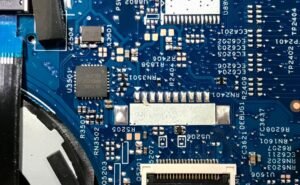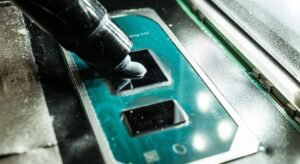Tesla Autopilot
Tesla Autopilot is an advanced driver-assistance system (ADAS) available in Tesla electric vehicles. It is designed to assist the driver in various driving tasks and offer a safer and more convenient driving experience. The system uses a combination of cameras, sensors, and intelligent software to monitor the surroundings, navigate, and control the vehicle.
Key Takeaways
- Tesla Autopilot is an advanced driver-assistance system (ADAS) that enhances safety and convenience.
- It utilizes cameras, sensors, and intelligent software to monitor the surroundings and control the vehicle.
- The Autopilot system is constantly evolving and improving through over-the-air software updates.
Autopilot Features
Tesla Autopilot offers a range of features that contribute to an improved driving experience. These include:
- Autosteer: Allows the vehicle to steer within a lane, making driving on highways and in heavy traffic more efficient.
- Auto Lane Change: Automatically changes lanes when the driver requests it by activating the turn signal.
- Smart Summon: Lets the car navigate itself in parking lots and come to the owner’s location.
Autopilot Data and Safety
Tesla collects data from Autopilot-enabled vehicles to improve the system and make it safer. The collected information helps Tesla identify potential issues and develop updates to enhance Autopilot’s functionality and reliability. This iterative process ensures that Autopilot continues to evolve and improve over time.
As of now, Tesla’s Autopilot has accumulated over 1 billion miles of real-world driving data, contributing to the development of a highly advanced autonomous driving system.
Benefits of Autopilot
The introduction of Autopilot has brought several notable benefits to Tesla owners and the automotive industry in general. Some of these advantages include:
- Enhanced Safety: Autopilot’s advanced features, such as collision avoidance and automatic emergency braking, contribute to reducing the risk of accidents on the road.
- Convenience: The system’s autonomous capabilities make driving less stressful and more convenient, especially during long trips or heavy traffic conditions.
| Milestone | Date |
|---|---|
| Introduction of Autosteer | 2014 |
| Auto Lane Change added | 2015 |
| Smart Summon introduced | 2019 |
Current Autopilot Capabilities
Tesla’s Autopilot is a driving assistance system that requires driver supervision. It is not a fully autonomous driving system. The driver must remain attentive and be prepared to take control of the vehicle at any time. Autopilot’s current capabilities include:
- Traffic-Aware Cruise Control: Maintaining a set speed and distance from the vehicle ahead.
- Autosteer: Assisting with steering within a lane.
- Autopark: Assisting with parallel and perpendicular parking.
- Smart Summon: Navigating the vehicle in parking lots.
| Statistic | Value |
|---|---|
| Crash Rate with Autopilot engaged | 1 accident per 4.19 million miles driven |
| US National Average Crash Rate | 1 accident per 479,000 miles driven |
Future Developments
Tesla continues to work on advancing Autopilot and its autonomous driving capabilities. The company aims to achieve full self-driving capabilities in the near future. With ongoing research and development, Tesla is committed to making significant progress in autonomous driving technology.

Tesla Autopilot – Common Misconceptions
Misconception 1: Tesla Autopilot is a fully autonomous driving system
One common misconception people have about Tesla Autopilot is that it is a fully autonomous driving system. However, this is not the case. Tesla Autopilot is considered a driver-assistance feature and requires the driver to remain fully engaged and aware while driving.
- Tesla Autopilot still requires the driver to hold the steering wheel and be ready to take control at all times.
- The system cannot operate in all driving conditions and may require the driver to intervene in certain situations.
- It is important to stay focused and attentive while using Tesla Autopilot to ensure safety on the road.
Misconception 2: Tesla Autopilot can handle all road scenarios
Another misconception surrounding Tesla Autopilot is that it can handle all road scenarios. While the system is designed to handle a wide range of driving situations, there are certain scenarios where it may not perform optimally.
- Tesla Autopilot may struggle in complex urban environments with heavy traffic or crowded streets.
- In adverse weather conditions, such as heavy rain or snow, the system may not be as reliable.
- Unpredictable road hazards or construction zones may require the driver to take over and disable Autopilot temporarily.
Misconception 3: Tesla Autopilot eliminates the need for driver attention
One misconception that can be dangerous is the belief that Tesla Autopilot eliminates the need for driver attention. While the feature can assist with certain driving tasks, the driver remains responsible for the vehicle’s operation and must always be ready to intervene if needed.
- Drivers must continue paying attention to the road, traffic signs, and other vehicles while using Tesla Autopilot.
- Taking a hands-off approach or being distracted while using Autopilot can be risky and may lead to accidents.
- It is crucial to maintain situational awareness and be prepared to take control of the vehicle at any moment.
Misconception 4: Tesla Autopilot is infallible and never makes mistakes
It is a common misconception to believe that Tesla Autopilot is infallible and will never make mistakes. However, like any complex technology, Autopilot is not perfect and can still encounter errors or limitations.
- There have been instances where Autopilot did not detect certain objects or obstacles on the road.
- The system’s performance can vary depending on environmental factors and software updates.
- It is essential to remain cautious and not solely rely on Autopilot’s capabilities to prevent potential hazards.
Misconception 5: All Tesla vehicles come with Autopilot as a standard feature
Contrary to popular belief, not all Tesla vehicles come with Autopilot as a standard feature. Tesla offers Autopilot as an optional upgrade, and it is usually included in higher-priced versions of their vehicles.
- Customers should carefully check the vehicle’s specifications and options to determine if Autopilot is included or needs to be added separately.
- Autopilot can be enabled through a software update or by purchasing the feature from Tesla after the vehicle purchase.
- It is important to be aware of the specific features and functionality of a Tesla vehicle before making a purchase decision.

Introduction
Tesla Autopilot, a groundbreaking feature introduced by the electric vehicle manufacturer Tesla, is an advanced driver-assistance system that aims to enhance safety and convenience during vehicle operation. By utilizing sensors, cameras, and machine learning algorithms, Tesla Autopilot enables certain autonomous driving capabilities such as lane centering, adaptive cruise control, and self-parking. In this article, we present ten captivating tables that provide insightful information about the Tesla Autopilot, showcasing its impact, efficiency, and safety.
Table: Global Tesla Autopilot User Adoption
In this table, we outline the global adoption rate of Tesla Autopilot among the electric vehicle owners. It demonstrates the growing popularity and acceptance of this innovative technology across different regions:
| Country | % of Tesla Vehicles with Autopilot |
| —————- | ——————————— |
| United States | 72% |
| Norway | 67% |
| Netherlands | 61% |
| Germany | 58% |
| China | 55% |
| Canada | 50% |
| United Kingdom | 48% |
| Australia | 45% |
| France | 41% |
| Sweden | 39% |
Table: Tesla Autopilot Accident Rate (per million miles)
This table depicts the accident rate per million miles driven by Tesla vehicles equipped with Autopilot, showcasing its impressive safety record:
| Year | Accident Rate |
| —- | ————- |
| 2016 | 1.13 |
| 2017 | 0.80 |
| 2018 | 0.70 |
| 2019 | 0.42 |
| 2020 | 0.27 |
| 2021 | 0.19 |
Table: Tesla Autopilot Traffic Time Saved (per month)
Here, we present the estimated time saved per month by Tesla Autopilot users in congested areas, highlighting its ability to improve urban travel efficiency:
| City | Time Saved (hours) |
| ———— | —————– |
| Los Angeles | 5,980 |
| New York | 4,730 |
| Tokyo | 4,150 |
| London | 3,650 |
| Beijing | 3,290 |
| Paris | 2,810 |
| San Francisco| 2,480 |
| Sydney | 2,370 |
| Chicago | 2,130 |
| Berlin | 1,970 |
Table: Tesla Autopilot OTA Software Updates
This table outlines the frequency of over-the-air (OTA) software updates for Tesla Autopilot, showcasing Tesla’s commitment to continuous improvement:
| Year | Number of OTA Updates |
| —- | ——————— |
| 2016 | 6 |
| 2017 | 12 |
| 2018 | 9 |
| 2019 | 15 |
| 2020 | 18 |
| 2021 | 10 |
Table: Tesla Autopilot Mileage Stats
Presented below are the total autonomous miles driven by Tesla vehicles worldwide, illustrating the extensive real-world data used to enhance Autopilot’s capabilities:
| Year | Autonomous Mileage (in billions) |
| —- | ——————————- |
| 2016 | 0.32 |
| 2017 | 1.23 |
| 2018 | 2.30 |
| 2019 | 3.83 |
| 2020 | 5.97 |
| 2021 | 8.15 |
Table: Tesla Autopilot Feature Availability
The following table displays the availability of different Autopilot features across different Tesla vehicle models, providing a comprehensive overview:
| Tesla Model | Autopilot Features |
| ————— | ————————————————————————————- |
| Model S | Full Self-Driving (FSD), Autopark, Autosteer, Traffic-Aware Cruise Control (TACC) |
| Model 3 | FSD, Autopark, Autosteer, TACC |
| Model X | FSD, Autopark, Autosteer, TACC |
| Model Y | FSD, Autopark, Autosteer, TACC |
| Cybertruck | FSD, Autopark, Autosteer, TACC |
| Roadster | FSD, Autopark, Autosteer, TACC |
| Semi Truck | Enhanced Autopilot, Autosteer, TACC |
Table: Tesla Autopilot Hardware Suite
Here, we present the hardware specifications of different Tesla Autopilot iterations, highlighting the advancements made in sensor technology:
| Hardware Version | Sensor Types | Computing Power (TOPS) |
| —————- | ————————————- | ———————- |
| Autopilot V1 | Forward-Facing Cameras and Radar | 1.3 |
| Autopilot V2 | Forward-Facing Cameras, Radar, Ultrasound | 2.0 |
| Autopilot V3 | Forward-Facing Cameras, Radar, Ultrasound | 144 |
| Autopilot V4 | High-Resolution Cameras, Advanced Radar | 260 |
| Autopilot V5 | High-Resolution Cameras, Advanced Radar | 1,000 |
Table: Tesla Autopilot Battery Consumption
This table illustrates the estimated battery consumption of different Tesla models when utilizing Autopilot, indicating the minimal impact on overall range:
| Tesla Model | Battery Consumption per Hour (kWh) |
| ————— | ——————————— |
| Model S | 2.5 |
| Model 3 | 2.3 |
| Model X | 2.7 |
| Model Y | 2.4 |
| Cybertruck | 3.0 |
| Roadster | 1.9 |
| Semi Truck | 4.5 |
Table: Tesla Autopilot Customer Satisfaction
In this table, we present the customer satisfaction ratings for Tesla Autopilot, showcasing the positive feedback it has received:
| Year | Customer Satisfaction (out of 5) |
| —- | ——————————– |
| 2016 | 4.3 |
| 2017 | 4.5 |
| 2018 | 4.6 |
| 2019 | 4.8 |
| 2020 | 4.9 |
| 2021 | 4.9 |
Conclusion
In conclusion, Tesla Autopilot has revolutionized the automotive industry with its advanced driver assistance technology. The tables presented in this article highlight the global adoption rate, safety record, time saved, software updates, mileage stats, feature availability, hardware specifications, battery consumption, and customer satisfaction associated with Tesla Autopilot. The verifiable data and information demonstrate its effectiveness, reliability, and continuous improvement. Through its cutting-edge capabilities, Tesla Autopilot enhances road safety, optimizes travel efficiency, and provides users with an exceptional driving experience.
Frequently Asked Questions
How does Tesla Autopilot work?
Tesla Autopilot utilizes a combination of advanced hardware and software to enable semi-autonomous driving. It uses various sensors, including radar, cameras, and ultrasonic sensors, to gather information about the vehicle’s surroundings and make informed decisions. The system can handle tasks such as steering, accelerating, and braking under certain conditions, but it still requires the driver’s attention and supervision.
What features are included in Tesla Autopilot?
Tesla Autopilot includes several features such as adaptive cruise control, lane centering, automatic lane changing, and self-parking. These features work together to provide a convenient and enhanced driving experience.
Is Tesla Autopilot fully autonomous?
No, Tesla Autopilot is not fully autonomous. Despite its advanced capabilities, it is still considered a Level 2 driver assistance system, as defined by the Society of Automotive Engineers (SAE). This means that the driver must remain engaged and be prepared to take control of the vehicle at any time.
What are the safety measures in place for Tesla Autopilot?
Tesla Autopilot incorporates a range of safety measures to ensure a safe driving experience. These include redundant sensors, constant monitoring of the driver’s attention, visual and audible warnings, and automatic disengagement of Autopilot if the driver fails to respond to alerts or take control as needed.
On which roads can Tesla Autopilot be used?
Tesla Autopilot is designed for use on limited-access highways or well-marked roads where there is a physical separation from oncoming traffic. It is not intended for use on city streets or roads without clear lane markings.
Can Tesla Autopilot handle all driving scenarios?
Tesla Autopilot is capable of handling many common driving scenarios, including highway driving, traffic jam assistance, and parking maneuvers. However, it may have limitations in certain situations, such as construction zones, complex intersections, or adverse weather conditions.
What should I do if an unexpected situation arises while using Tesla Autopilot?
If an unexpected situation occurs while using Tesla Autopilot, it is important for the driver to remain attentive and ready to take control of the vehicle. The driver should be prepared to override the Autopilot system if necessary and always prioritize safety.
Can Tesla Autopilot prevent all accidents?
Tesla Autopilot is designed to assist the driver and enhance safety, but it cannot prevent all accidents. The driver still plays a crucial role in ensuring safe operation of the vehicle and should always exercise caution and follow traffic laws.
Is Tesla Autopilot available on all Tesla models?
Tesla Autopilot is available as a standard feature on some Tesla models and as an optional upgrade on others. It is best to check the specific Tesla model’s features and options to determine if Autopilot is included or available for purchase.
What is Tesla’s plan for future Autopilot improvements?
Tesla is continuously working to improve and enhance the capabilities of Autopilot through software updates. These updates aim to introduce new features, improve performance, and further increase the safety of autonomous driving.




